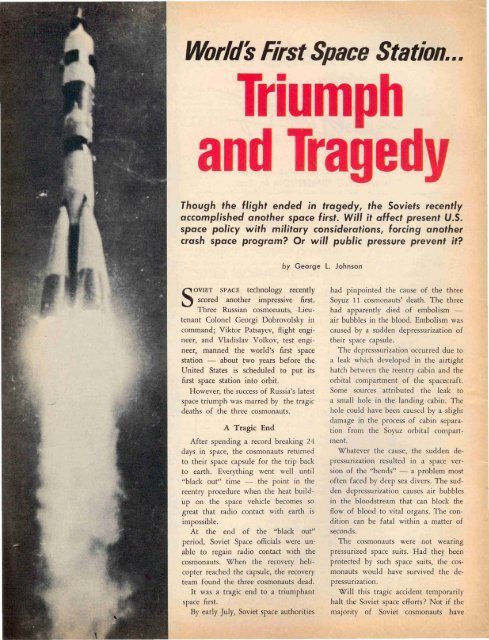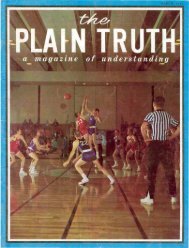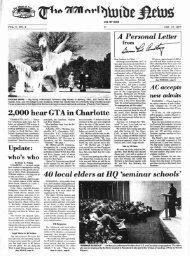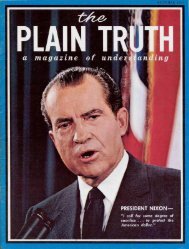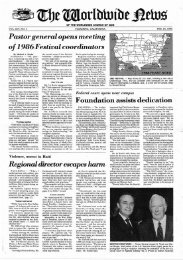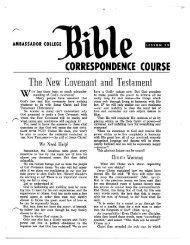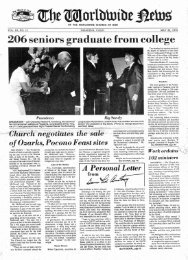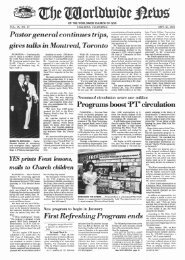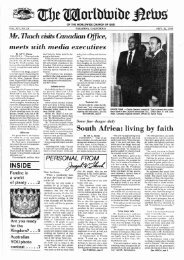Plain Truth 1971 (Prelim No 08) Aug - Herbert W. Armstrong
Plain Truth 1971 (Prelim No 08) Aug - Herbert W. Armstrong
Plain Truth 1971 (Prelim No 08) Aug - Herbert W. Armstrong
Create successful ePaper yourself
Turn your PDF publications into a flip-book with our unique Google optimized e-Paper software.
World's First Space Station...<br />
a<br />
a<br />
Though the flight ended in tragedy, the Soviets recently<br />
accomplished another space first. Will it affect present U.S.<br />
space policy with military considerations, forcing another<br />
crash space program? Or will public pressure preve nt it?<br />
A Tragic End<br />
by George<br />
OVIET SPACE technol ogy recently<br />
scored another impressive first.<br />
ST hree Russian cosmonauts, Lieutenant<br />
Colone l Geo rg i Dobrovolsky in<br />
command; Viktor Patsayev, flight engi <br />
neer, and Vladislav Volkov, test engineer,<br />
manned th e world's first spa ce<br />
station - about two years before the<br />
United States is scheduled to put its<br />
first space station into orbit.<br />
However, the success of Russia's latest<br />
space triumph was ma rred by the tragic<br />
deaths of the three cosmonauts.<br />
After spending a record breaking 24<br />
days in space, the cosmonauts returned<br />
to their space capsule for the trip back<br />
to earth . Everything went well until<br />
"black out" time - the point in the<br />
reentry procedure when the heat buildup<br />
on the space veh icle becomes so<br />
great th at radio contact with earth is<br />
impossible.<br />
At th e end of the "black out"<br />
period, Soviet Space officials were unable<br />
to regain radio contact with the<br />
cosmonauts. When the recovery helicopter<br />
reached the capsu le, the recovery<br />
team found the th ree cosmo nauts dea d.<br />
It was a tragic end to a triump hant<br />
space first.<br />
By early July , Soviet space authorities<br />
L. Joh nson<br />
had pinpointed the cause of the three<br />
Soyuz 11 cosmonauts' death . The three<br />
had apparently died of embolism <br />
air bubbles in the blood. Embolism was<br />
caused by a sudden depressurization of<br />
their space capsule.<br />
The depresssurization occurred due to<br />
a leak which developed in the air tight<br />
hatch betw een the reentry cabin and the<br />
orbital compartment of the spacecraft.<br />
Some sources attributed the leak to<br />
a small hole in the landing cabin. The<br />
hole could have been caused by a sligh t<br />
damage in the process of cabin separation<br />
from the Soyuz orbital compartment.<br />
Whatever the cause, the sudden depressurization<br />
resulted in a space version<br />
of the "b ends" - a problem most<br />
often faced by deep sea divers. The sudden<br />
depressurization causes air bubbles<br />
in the bloodstream that can block the<br />
flow of blood to vita l organs . The condition<br />
can be fatal within a mat ter of<br />
seconds.<br />
The cosmonauts were not wearing<br />
pre ssurized space suits . Had they been<br />
protected by such space suits, the cosmonauts<br />
would have survived the depressurization.<br />
Will this tragic accident temporarily<br />
halt th e Soviet space efforts ? N ot if the<br />
ma jority of Soviet cosmon auts have


